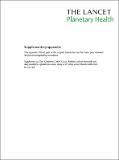Por favor, use este identificador para citar o enlazar a este item:
http://hdl.handle.net/10261/240261COMPARTIR / EXPORTAR:
 SHARE SHARE
 CORE
BASE CORE
BASE
|
|
| Visualizar otros formatos: MARC | Dublin Core | RDF | ORE | MODS | METS | DIDL | DATACITE | |

| Título: | Ambient carbon monoxide and daily mortality: a global time-series study in 337 cities |
Autor: | Chen, Kai; Breitner, Susanne; Tobías, Aurelio CSIC ORCID; Gasparrini, Antonio; Schneider, Alexandra | Palabras clave: | Ambient carbon monoxide Daily mortality |
Fecha de publicación: | 1-abr-2021 | Editor: | Elsevier | Citación: | The Lancet Planetary 5 (4): E191-E199 (2021) | Resumen: | Background Epidemiological evidence on short-term association between ambient carbon monoxide (CO) and mortality is inconclusive and limited to single cities, regions, or countries. Generalisation of results from previous studies is hindered by potential publication bias and different modelling approaches. We therefore assessed the association between short-term exposure to ambient CO and daily mortality in a multicity, multicountry setting. Methods We collected daily data on air pollution, meteorology, and total mortality from 337 cities in 18 countries or regions, covering various periods from 1979 to 2016. All included cities had at least 2 years of both CO and mortality data. We estimated city-specific associations using confounder-adjusted generalised additive models with a quasi-Poisson distribution, and then pooled the estimates, accounting for their statistical uncertainty, using a random-effects multilevel meta-analytical model. We also assessed the overall shape of the exposure–response curve and evaluated the possibility of a threshold below which health is not affected. Findings Overall, a 1 mg/m3 increase in the average CO concentration of the previous day was associated with a 0·91% (95% CI 0·32–1·50) increase in daily total mortality. The pooled exposure–response curve showed a continuously elevated mortality risk with increasing CO concentrations, suggesting no threshold. The exposure–response curve was steeper at daily CO levels lower than 1 mg/m3, indicating greater risk of mortality per increment in CO exposure, and persisted at daily concentrations as low as 0·6 mg/m3 or less. The association remained similar after adjustment for ozone but was attenuated after adjustment for particulate matter or sulphur dioxide, or even reduced to null after adjustment for nitrogen dioxide. Interpretation This international study is by far the largest epidemiological investigation on short-term CO-related mortality. We found significant associations between ambient CO and daily mortality, even at levels well below current air quality guidelines. Further studies are warranted to disentangle its independent effect from other traffic-related pollutants. | Versión del editor: | https://doi.org/10.1016/S2542-5196(21)00026-7 | URI: | http://hdl.handle.net/10261/240261 | DOI: | 10.1016/S2542-5196(21)00026-7 |
| Aparece en las colecciones: | (IDAEA) Artículos |
Ficheros en este ítem:
| Fichero | Descripción | Tamaño | Formato | |
|---|---|---|---|---|
| PIIS2542519621000267.pdf | Artículo principal | 1,6 MB | Adobe PDF |  Visualizar/Abrir |
| mmc1.pdf | Material suplementario | 1,22 MB | Adobe PDF |  Visualizar/Abrir |
CORE Recommender
SCOPUSTM
Citations
35
checked on 12-abr-2024
Page view(s)
53
checked on 18-abr-2024
Download(s)
66
checked on 18-abr-2024
Google ScholarTM
Check
Altmetric
Altmetric
NOTA: Los ítems de Digital.CSIC están protegidos por copyright, con todos los derechos reservados, a menos que se indique lo contrario.
